Orbital Sciences' Antares Rocket Explosion in Pictures
On Oct. 28, 2014, an Orbital Sciences-built Antares rocket exploded during liftoff during a mission to deliver cargo to the International Space Station for NASA. See photos from the stunning rocket launch failure here. Read the Full Story: Private Orbital Sciences Rocket Explodes During Launch, NASA Cargo Lost
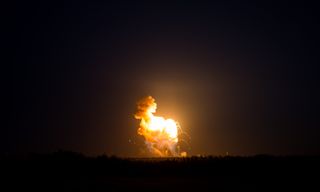
NASA has released a series of photos of the Orbital Sciences rocket explosion taken by photographer Joel Kowsky. Here, the Antares rocket is seen erupting in a giant fireball about 10 seconds after liftoff. Credit: NASA/Joel Kowsky.

Here, NASA photographer Joel Kowsky captures the moment of a "catastrophic anomaly" on the Antares rocket just after it lifted off from Pad-0A at the Wallops Flight Facility on Wallops Island, Virginia. The rocket's upper half is clearly visible here, with what appears to be an explosion near its aft. Credit: NASA/Joel Kowsky.
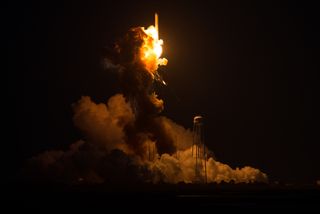
Another view of the first seconds of the Antares rocket's destruction by NASA photographer Joel Kowsky. Credit: NASA/Joel Kowsky.

A towering smoke plume rises over Pad-0A at NASA's Wallops Flight Facility after the explosion of the Orbital Sciences-built Antares rocket. Credit: NASA/Joel Kowsky.

This still image, taken just seconds after the Antares rocket lifted off from Pad-0A at NASA's Wallops Flight Facility on Wallops Island, Virginia, shows the shocking outcome: a towering fireball as the commercial rocket and its robotic Cygnus spacecraft are destroyed in a fireball shortly after a 6:22 p.m. EDT (2222 GMT) launch. The mission was carrying 5,000 lbs. of cargo bound for the International Space Station - Orbital's third of eight resupply missions under a $1.9 billion contract with NASA. Credit: NASA TV.

The rocket failure occured after a relatively smooth launch countdown. Here the Antares rocket is seen just before liftoff at its seaside launch pad. Orbital Sciences initially tried to launch the Antares rocket on Monday, Oct. 27, but a stray boat wandered into the launch safety range offshore, forcing flight controllers to postpone the launch try. Credit: NASA TV.
Get the Space.com Newsletter
Breaking space news, the latest updates on rocket launches, skywatching events and more!

At T-0, the Antares rocket's liquid-fueled first stage ignited, lifting the booster off the launch pad as seen here. But within 10 seconds of the launch, the first sign of an anomaly was seen, Orbital Sciences representatives said. Credit: NASA TV.

Seconds after liftoff, it was clear that something was wrong. Robert Pearlman, editor of the space history news website collectSPACE.com (a Space.com partner) told us the following: "As the vehicle was climbing off the pad, there was something trailing — a smoke and fire plume from the rocket itself — trailing from the rocket all the way up. As it cleared the top of the water tower, there was a clear break-apart, and the booster's integrity failed. There was then a tremendous fireball, trailed by a very loud explosion. Parts were sent flying everywhere, and then the vehicle fell back to the pad, exploding in an even larger fireball, setting the entire area on fire." [Listen to Pearlman's first-hand account of the rocket explosion] Credit: Robert Pearlman/collectSPACE.com.

This view of the Antares rocket explosion by Robert Pearlman of collectSPACE.com shows the rocket just after liftoff, as disaster set in. Image Credit: Robert Pearlman/collectSPACE.com.

Pearlman caught this photo of the launch just after engine ignition. Orbital Sciences' Antares rocket is a two-stage booster with a liquid-fueled first stage and a solid rocket motor upper stage. Credit: Robert Pearlman/collectSPACE.com.
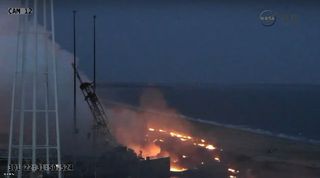
After the Antares rocket slammed into the ground and exploded, it left fiery debris strewn around its Pad-0A launch. NASA officials are warning the public not to touch any debris from the rocket that may wash up on Virginia's Eastern Shore or be found in farms surrounding the launch site. Credit: NASA TV.

Another view of the fires sparked by the Antares rocket explosion. NASA Wallops Flight Facility director Bill Wrobel said that much of th damage was limited to the southern part of Wallops Island, and that an investigation team will begin the long process of recovering debris on Wednesday morning (Oct. 29) at daybreak. Credit: NASA TV.

Wrobel said Wallops fire authorities opted to let most of the fires from the Antares rocket explosion burn out on their own as a safety measure for recovery teams. Substantial damage to the Pad-0A structure at Wallops, as well as the Antares and its Cygnus spacecraft, were clearly evident. Credit: NASA TV.

A wide view of the smoke plume and fire from the Antares rocket failure and explosion at Pad-0A of NASA's Wallops Flight Facility on Wallops Island, Virginia. Credit: NASA TV.

NASA spokesperson Rachel Kraft (left), Orbital Sciences executive vice president Frank Culbertson (center) and Bill Wrobel, director of NASA's Wallops Flight Facility, answer questions from the media after the Antares rocket launch failure. Credit: NASA TV.
Videos:
Below are photos of the rocket as it was prepared to launch the Cygnus Orb-3 mission:

The Orbital Sciences Corporation Antares rocket, with the Cygnus spacecraft attached, stands on launch Pad-0A at sunrise, Oct. 26, 2014, at NASA's Wallops Flight Facility in Virginia.
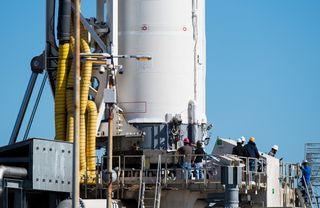
The Orbital Sciences Corporation Antares rocket carrying the Cygnus spacecraft stands on launch Pad-0A, Oct. 26, 2014, at NASA's Wallops Flight Facility in Virginia, in preparation for a launch scheduled for Oct. 27, 6:45 pm.

This map shows how far above the horizon that Antares rocket will reach during its first stage burn. The maximum elevation depends on distance from the launch site; the further away one is, the closer to the horizon the rocket will appear.

Residents in the mid-Atlantic may have a chance to view the Antares launch scheduled for Oct. 27, 2014, weather permitting.

This guide shows what the Antares launch may look like for viewers in Fells Point in Baltimore, Maryland, on Oct. 27, 2014.

This guide will assist with viewing the Antares launch across the tidal basin from the Martin Luther King Jr. Memorial in Washington, D.C.

This guide will assist with viewing the Antares launch from River Road in North Bergen, New Jersey, looking south, on Oct. 27, 2014.
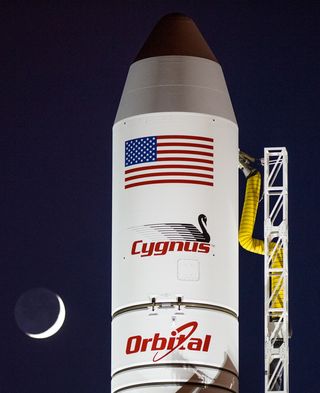
The Cygnus cargo spacecraft awaits launch atop The Orbital Sciences Corporation Antares rocket on launch Pad-0A, Oct. 26, 2014, at NASA's Wallops Flight Facility in Virginia.

The Orbital Sciences Corporation Antares rocket carrying the Cygnus spacecraft onboard stands on launch Pad-0A, Oct. 26, 2014, at NASA's Wallops Flight Facility in Virginia. Reflections of the launch vehicle appear in some foreground water.

The Cygnus cargo spacecraft awaits launch atop The Orbital Sciences Corporation Antares rocket on launch Pad-0A, Oct. 26, 2014, at NASA's Wallops Flight Facility in Virginia, amidst a welter of poles.
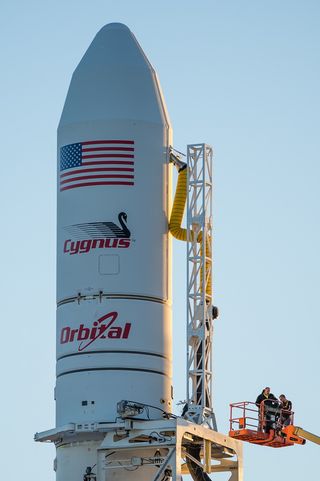
From a low angle, sunlibght strikes the Orbital Sciences Corporation Antares rocket carrying the Cygnus spacecraft on launch Pad-0A, Oct. 26, 2014, at NASA's Wallops Flight Facility in Virginia.
Follow us @Spacedotcom, Facebook and Google+. Original article on Space.com.
Join our Space Forums to keep talking space on the latest missions, night sky and more! And if you have a news tip, correction or comment, let us know at: community@space.com.

Space.com is the premier source of space exploration, innovation and astronomy news, chronicling (and celebrating) humanity's ongoing expansion across the final frontier. Originally founded in 1999, Space.com is, and always has been, the passion of writers and editors who are space fans and also trained journalists. Our current news team consists of Editor-in-Chief Tariq Malik; Editor Hanneke Weitering, Senior Space Writer Mike Wall; Senior Writer Meghan Bartels; Senior Writer Chelsea Gohd, Senior Writer Tereza Pultarova and Staff Writer Alexander Cox, focusing on e-commerce. Senior Producer Steve Spaleta oversees our space videos, with Diana Whitcroft as our Social Media Editor.









